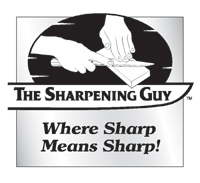Kitchen knives are divided into two major categories – Japanese knives and western (non-Japanese) knives. Below is a description of various types of Japanese knives.
Please let me know if you have any questions regarding purchasing or using a kitchen knife.
Japanese Knives
I like to say that Japanese knives are superior to non-Japanese knives because they have better metallurgy, better blade geometry, and are sharpened using superior methods. Because they tend to have thinner blades with a higher HRC (Rockwell Hardness Scale), they slice through food more easily and hold their edges for longer. Many of them are made with laminated blades which come with either carbon steel or stainless steel cores. Many of the double bevel knives with carbon steel cores now come laminated between two layers of stainless steel for easy knife maintenance. You can find Japanese knives with western style handles as well as the traditional wa style handles.
Double Bevel
- Gyuto
- This is the Japanese version of the chef knife. It is a great all around knife for both home and professional cooks. Most home cooks prefer a 210mm version while some professionals prefer a 240mm version. Gyuto blades tend to be taller, so knuckle clearance is not usually a problem.
- Sujihiki
- The sujihiki is an excellent slicing knife. This would be the closest double bevel equivalent of the yanagi-ba. A 210mm sujihiki is also a great all around knife for both home and professional cooks. Many people use a sujihiki instead of a gyuto. The sujihiki is often used with the handle off of the front of the cutting board and the index finger on the spine of the blade due to its narrow width.
- Nakiri
- This is a knife made specifically for cutting vegetables. It usually has a very thin blade with a slight curve upward at the tip. This is basically the double bevel version of the Usuba.
- Santoku
- Many home cooks enjoy this knife. The blade tends to be shorter than a gyuto and also have less of a point. It is a good knife for those who are a little scared of using a larger knife. Santoku blades tend to be taller, so knuckle clearance is not usually a problem. Do not confuse the Japanese santoku with the western version of the santoku which is quite different.
- Deba
- Although Debas are usually single bevel knives, you can find double bevel versions. This is the thickest of the Japanese knives. It is traditionally used for cutting fish, and would be used instead of a fillet knife.
- Petty
- The Japanese version of the paring knife or the utility knife. Petty knifes tend to have a heel that does not run into the handle or a bolster so the knife can be used against a cutting board. Some of the longer ones could be used as an all around knife. Some bladesmiths make long petty knives that could be called sujihikis.
Single Bevel (Kata-ha grind)
- Yanagiba
- The ultimate slicing knife. Traditionally used to prepare shashimi.
- Usuba
- Excellent vegetable knife. Great for peeling around foods like cucumbers.
- Deba
- The thickest of the Japanese knives. Traditionally used for cutting fish.
